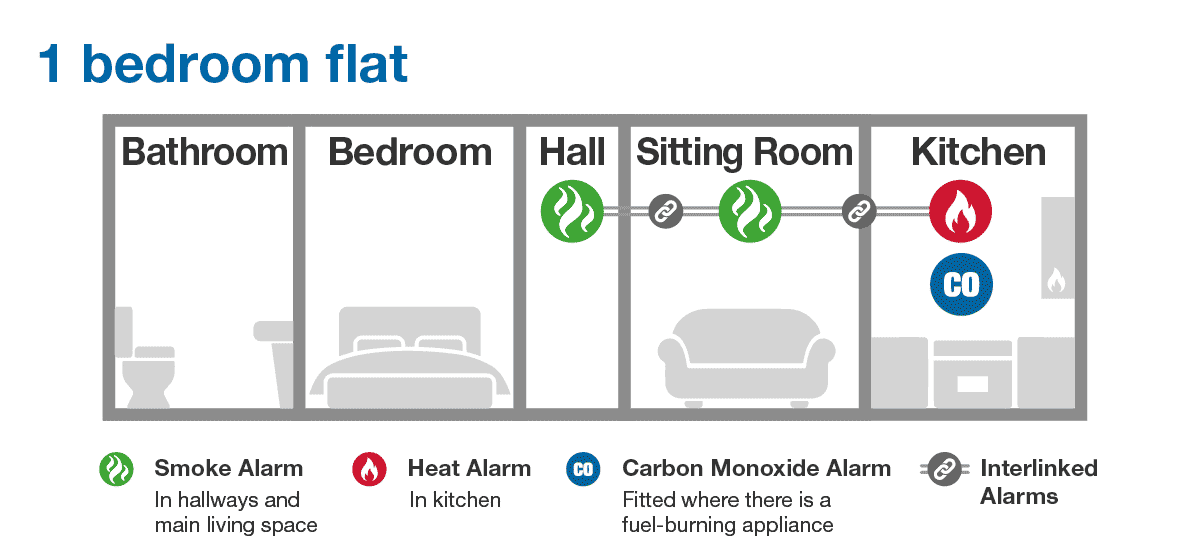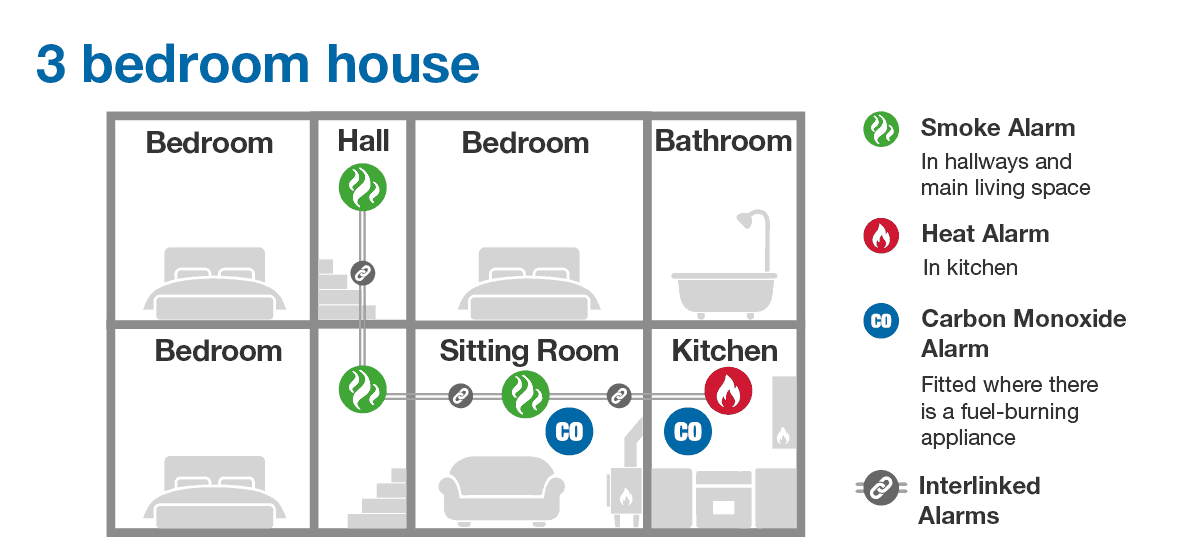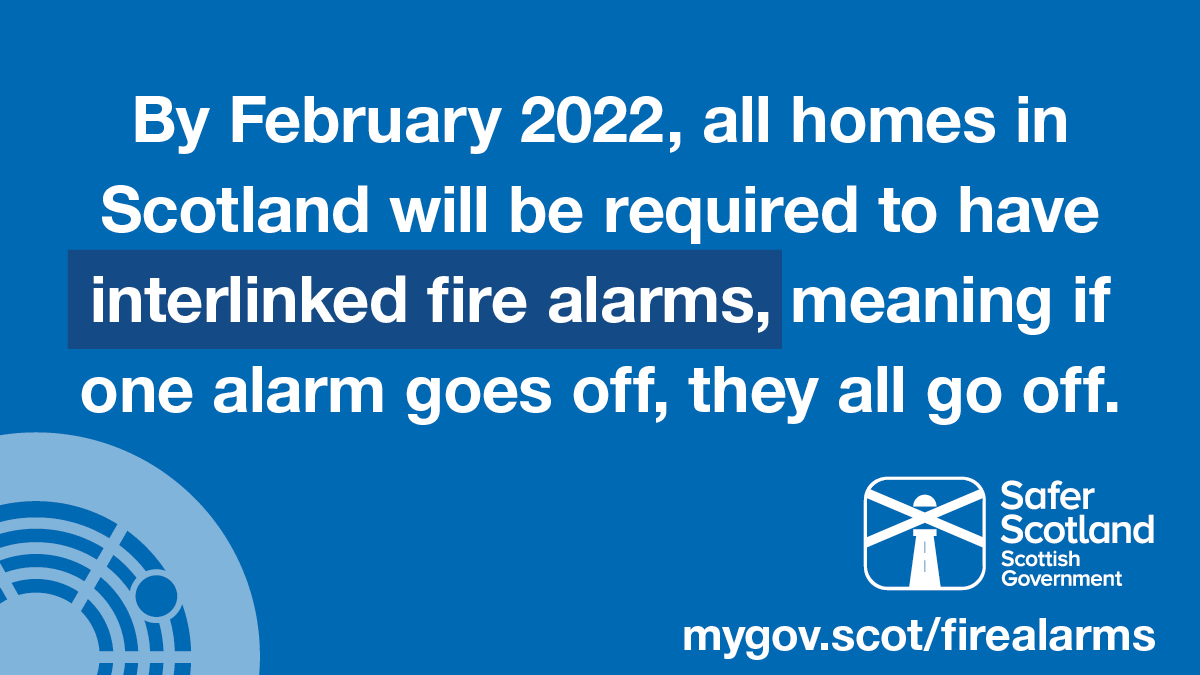The new fire alarms standard - the law is changing
20th October 2021
By February 2022 every home in Scotland must have interlinked fire alarms.
What are they? Interlinked fire alarms talk to each other. When one goes off, they all go off so you will hear them wherever you are in the house. This should help you to react quicker and could save your life.
Fire alarm contents
1. The 2 types of interlinked alarms2. What each home needs
3. Carbon monoxide detectors
4. Specialist alarms - e.g. Telecare systems
5. Visual examples of the requirements
6. Obtaining and installing alarms
7. Points to note for homeowners
8. Tennants and rented accommodation
9. Further information
1. There are 2 types of interlinked fire alarms:
-
- A sealed long life battery alarm which you can fit yourself
- A mains wired alarm which needs to be fitted by a qualified electrician
2. Every home needs:
- 1 smoke alarm in the room you spend most time in (usually your living room)
- 1 smoke alarm on every floor (either in the hallway or landing)
- 1 heat alarm in the kitchen
3. Carbon monoxide detectors
If your home has a carbon-fuelled appliance you will also need a carbon monoxide detector.You will need this if you have:
- A boiler
- A fire
- A heater
- A flue
4. Specialist alarms
If specialist alarms are needed – such as for deaf people or Telecare systems – these must be fitted in addition to any smoke, heat and carbon monoxide alarms.Interlinked smoke and heat alarms are required to be installed in addition to any Telecare smoke/heat alarms to help keep you safe. If you have fitted or are planning to fit interlinked smoke and heat alarms, please do not remove your telecare smoke, heat or carbon monoxide alarms.
5. Visual examples
Below are 2 examples of the requirements for a 1 bedroom flat and a 3 bedroom house.

6. Obtaining and installing alarms
DIY alarm kits
You can obtain interlinked alarms that you can fit yourself, or have fitted by any competent DIY enthusiast by visiting your local hardware or DIY store, or an online retailer. These tend to be more expensive than mains fitted alarms, but you don't have the extra expense of having them installed by a qualified electrician.Home DIY kits for a 3 bedroom house cost around £150 - £220 and the batteries should last for 10 years.
Professionally fitted alarms
If you want mains wired alarms, then these must be fitted by a qualified and competent electrician. You can see a list of Trading Standards vetted electricians by following these links to approvedtrader.scot or trustedtrader.scotYou can also find electricians by going to the Electrical Contractors' Association of Scotland (SELECT) or the National Inspection Council for Electrical Installation Contracting (NICEIC).
7. Points to note for homeowners
- If buying alarms yourself, look for a recognised brand. Read online reviews and make sure each alarm meets the following standard:
- Smoke alarms: BS EN14604:2005
- Heat alarms: BS 5446-2:2003
- Carbon monoxide detectors: British Kitemark EN 50291-1
- If using an electrician to fit your alarms, ask them to confirm all fitted alarms will conform to the required standards
- Not meeting the requirements could impact your home insurance. If you have any concerns, discuss them with your home insurance provider
- Most smoke and heat alarms can be recycled, either in your home recycling bin or at your local recycling centre
8. Tennants and rented accommodation
- If you rent from a private landlord, your home should already have interlinked fire alarms
- If your property does not have interlinked fire alarms, you should speak to your landlord as soon as possible
- If your landlord does not comply with the law, you can apply to a Tribunal (see below link for details)
- Different homes in a shared property like a tenement or block of flats do not need to be linked to each other, and there is no need for alarms to be fitted in communal areas such as entry halls and stairways
9. Further information
Below is an explainer video that explains the new requirements, followed by links to official sources where you can obtain more information.-
gov.scot - Fire and smoke alarms: changes to the law - Detailed information related to the new changes.
- mygov.scot - Fire safety for home owners - Information and responsibilities for homeowners.
- Scottish Fire and Rescue Service - Requesting home fire safety visits.
- Care and Repair Scotland - Talk to your local office to see if there is help available for elderly or disabled homeowners.
- Trading Standards - If you are worried about what someone is trying to sell you or telling you, call trading Standards Scotland on 0808 164 6000, or follow the link to find your local Trading Standards office.
- Taking your landlord to the Tribunal - A private landlord is a person or business who rents a home to you. You shouldn't use this notice if you rent from a local council or housing association.
Please share this article to anyone who would find this information useful.



